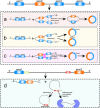Advances in the Identification of Circular RNAs and Research Into circRNAs in Human Diseases
- PMID: 33815488
- PMCID: PMC8017306
- DOI: 10.3389/fgene.2021.665233
Advances in the Identification of Circular RNAs and Research Into circRNAs in Human Diseases
Abstract
Circular RNAs (circRNAs) are a class of endogenous non-coding RNAs (ncRNAs) with a closed-loop structure that are mainly produced by variable processing of precursor mRNAs (pre-mRNAs). They are widely present in all eukaryotes and are very stable. Currently, circRNA studies have become a hotspot in RNA research. It has been reported that circRNAs constitute a significant proportion of transcript expression, and some are significantly more abundantly expressed than other transcripts. CircRNAs have regulatory roles in gene expression and critical biological functions in the development of organisms, such as acting as microRNA sponges or as endogenous RNAs and biomarkers. As such, they may have useful functions in the diagnosis and treatment of diseases. CircRNAs have been found to play an important role in the development of several diseases, including atherosclerosis, neurological disorders, diabetes, and cancer. In this paper, we review the status of circRNA research, describe circRNA-related databases and the identification of circRNAs, discuss the role of circRNAs in human diseases such as colon cancer, atherosclerosis, and gastric cancer, and identify remaining research questions related to circRNAs.
Keywords: circRNAs; circRNAs identification; database; diseases; machine learning.
Copyright © 2021 Jiao, Wu, Huang, Liu and Gao.
Conflict of interest statement
The authors declare that the research was conducted in the absence of any commercial or financial relationships that could be construed as a potential conflict of interest.
Figures
Similar articles
-
Review on circular RNAs and new insights into their roles in cancer.Comput Struct Biotechnol J. 2021 Jan 22;19:910-928. doi: 10.1016/j.csbj.2021.01.018. eCollection 2021. Comput Struct Biotechnol J. 2021. PMID: 33598105 Free PMC article. Review.
-
Progress in Understanding the Relationship Between Circular RNAs and Neurological Disorders.J Mol Neurosci. 2018 Aug;65(4):546-556. doi: 10.1007/s12031-018-1125-z. Epub 2018 Aug 1. J Mol Neurosci. 2018. PMID: 30069802 Review.
-
Circular RNAs are miRNA sponges and can be used as a new class of biomarker.J Biotechnol. 2016 Nov 20;238:42-51. doi: 10.1016/j.jbiotec.2016.09.011. Epub 2016 Sep 23. J Biotechnol. 2016. PMID: 27671698 Review.
-
Circular RNAs: A novel type of biomarker and genetic tools in cancer.Oncotarget. 2017 Jun 2;8(38):64551-64563. doi: 10.18632/oncotarget.18350. eCollection 2017 Sep 8. Oncotarget. 2017. PMID: 28969093 Free PMC article. Review.
-
circRNAs Signature as Potential Diagnostic and Prognostic Biomarker for Diabetes Mellitus and Related Cardiovascular Complications.Cells. 2020 Mar 9;9(3):659. doi: 10.3390/cells9030659. Cells. 2020. PMID: 32182790 Free PMC article. Review.
Cited by
-
The hsa_circ_0039857/miR-338-3p/RAB32 axis promotes the malignant progression of colorectal cancer.BMC Gastroenterol. 2022 Dec 20;22(1):530. doi: 10.1186/s12876-022-02622-1. BMC Gastroenterol. 2022. PMID: 36539702 Free PMC article.
-
Circ_0005526 contributes to interleukin-1β-induced chondrocyte injury in osteoarthritis via upregulating transcription factor 4 by interacting with miR-142-5p.Bioengineered. 2022 Apr;13(4):8407-8418. doi: 10.1080/21655979.2022.2048773. Bioengineered. 2022. PMID: 35322736 Free PMC article.
-
Evaluation of circ_0002232 and circ-vimentin gene expressions as valuable biomarkers in acute myeloid leukemia patients.Mol Biol Rep. 2025 Jan 7;52(1):105. doi: 10.1007/s11033-024-10113-7. Mol Biol Rep. 2025. PMID: 39776264
-
Circular RNA circβ-catenin aggravates the malignant phenotype of non-small-cell lung cancer via encoding a peptide.J Clin Lab Anal. 2021 Sep;35(9):e23900. doi: 10.1002/jcla.23900. Epub 2021 Jul 23. J Clin Lab Anal. 2021. PMID: 34296778 Free PMC article.
-
circ-LIMK1 regulates cisplatin resistance in lung adenocarcinoma by targeting miR-512-5p/HMGA1 axis.Open Med (Wars). 2022 Oct 7;17(1):1568-1583. doi: 10.1515/med-2022-0542. eCollection 2022. Open Med (Wars). 2022. PMID: 36304135 Free PMC article.
References
-
- Boeckel J. N., Jae N., Heumueller A. W., Chen W., Boon R. A., Stellos K., et al. (2015). Identification and. characterization of hypoxia-regulated endothelial circular RNA. Circ. Res. 117 884–890. - PubMed
Publication types
LinkOut - more resources
Full Text Sources
Other Literature Sources
Research Materials



